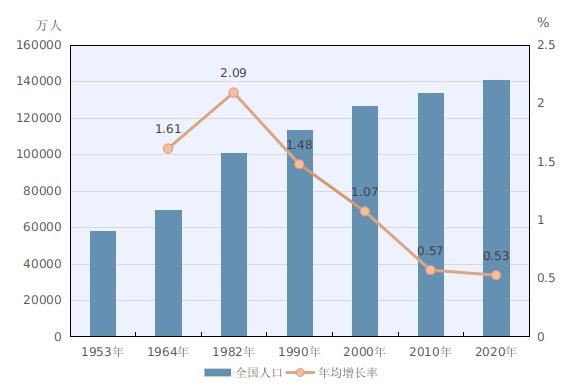【背景】
5月11日,国家统计局公布第七次全国人口普查主要数据结果。数据显示,全国人口共141178万人,与2010年的133972万人相比,增加了7206万人,增长5.38%;年平均增长率为0.53%,比2000年到2010年的年平均增长率0.57%下降0.04个百分点。数据表明,我国人口10年来继续保持低速增长态势。
【新闻】
请看《中国日报》的报道
The State Council Information Office held a news conference on the outcome of the seventh national population census on Tuesday.
国务院新闻办公室22日举行新闻发布会,介绍第七次全国人口普查结果。
【讲解】
the seventh national population census是第七次全国人口普查。
我国总人口(total population)为141178万人。同2010年第六次全国人口普查数据相比,增加7206万人,增长5.38%,年平均增长率(annual growth rate)为0.53%。
我国60岁及以上人口(Chinese aged 60 and above)为26402万人,占总人口的占18.70%,较第六次人口普查上升5.44个百分点(percentage points)。
最新人口普查显示,我国的人口性别比(sex ratio)正朝着更加平衡的方向发展。
我国男性人口(the number of male)为72334万人,占(account for)总人口的(the whole population)51.24%;女性人口为68844万人,占48.76%。
总人口性别比(the male to female ratio)为105.07,与2010年基本持平,略有降低(a slight drop)。
出生人口性别比(sex ratio at birth)2020年为111.3,较2010年降低了6.8。
根据第七次全国人口普查结果,居住在中国大陆的外籍人员(foreigners living on the Chinese mainland)845697人,十年前这一数字为593832人。
报告显示,居住在中国大陆的香港特别行政区居民(residents from Hong Kong)、澳门特别行政区居民、台湾地区居民和外籍人员合计1430695人。
其中,居住时间三个月以下的40659人;居住时间五年以上(lived in China for more than five years)的603682人。
上述人员中,以商务为目的(came to China for business)77008人;以就业(employment)为目的444336人;以学习为目的219761人;以定居为目的(came to settle down)419517人;以探亲(pay visits to family members)为目的74735人;其他目的195338人。
上述人员按居住地分,海外居民最多(the largest number of overseas residents)的是广东省418509人,其次是云南379281人,上海163954人,福建106248人,北京62812人。
2020年全国人口普查显示,近十年来,少数民族人口增长率明显高于汉族,这表明不同民族的人口都受益于中国的全面发展(benefitted from China’s all-round development)。
全国人口中,汉族(Han ethnic group)人口为1286311334人,占91.11%;各少数民族(ethnic groups)人口为125467390人,占8.89%。与2010年第六次全国人口普查相比,汉族人口增加60378693人,增长(the growth rate)4.93%;各少数民族人口增加11675179人,增长10.26%。
此外,少数民族人口占全国总人口的比例(the proportion of people from ethnic groups in the country's total population)比上次人口普查提高了0.4个百分点。
中国有56个民族。最新人口普查显示,除汉族以外的少数民族人口稳定增长(steady growth),充分体现了各民族人口的均衡发展(the balanced development of people all ethnic groups)。
最新人口普查显示,越来越多的人向东部发达区域(developed regions)和城市群(city clusters)聚集。
东部地区人口(the number of people living in East China)占39.93%,人口所占比重上升2.15个百分点。
中部地区人口(those residing in the central region)占25.83%,西部地区占(take up)27.12%,东北地区占比(the proportion of residents in Northeast China)6.98%。与2010年相比,中部地区下降(decline)0.79个百分点,西部地区上升0.22个百分点,东北地区下降1.20个百分点。

可可原创,未经许可请勿转载












